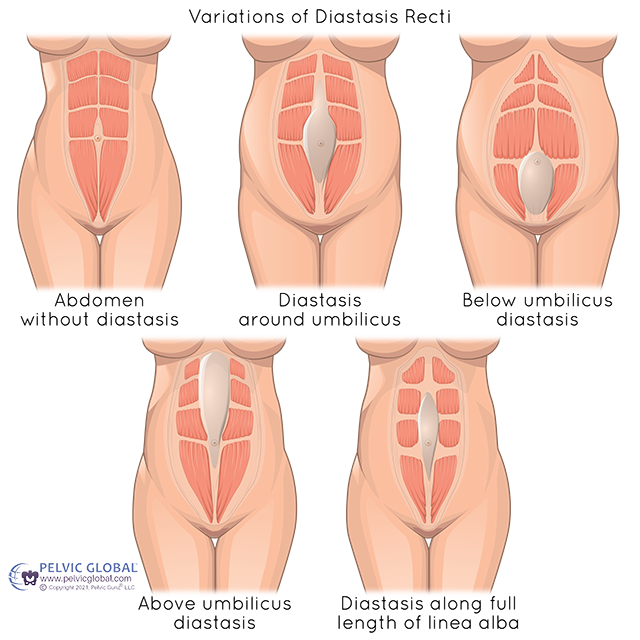Diastasis recti abdominis (DRA) is the separation of the rectus abdominis or 6 pack muscles in the abdomen. Typically, DRA occurs during pregnancy allowing for growth of the baby. After delivery about 60% of people return to normal after some time. But the remaining 40% of people may still have a separation. 1 to 2 finger widths with good activation of the transverse abdominis is considered normal after pregnancy.
What are the symptoms?
Illustrated in the image below, a separation may look like something is doming or bulging in the middle of the abdomen. It may be limited to a small part or the full length of your abs (rectus abdominis). DRA can lead to pelvic floor dysfunctions including bladder leaking, back pain, abdominal pain. For some there is no pain but more of just an uncomfortable feeling as well as feeling like your clothes are not fitting correct.

Does DRA limit my ability to exercise?
Some people worry about returning to different activities for fear of making it worse after they hear not to do any abdominal work. Educating yourself on what is safe for you, will allow you return to most of your activities that you want to without the separation to becoming worse.
Is pregnancy the only cause?
No, weight gain or abdominal surgeries can also cause the separation to occur.
Can a DRA be fixed?
A specially trained pelvic floor PT provides treatments that will often correct the separation, even if you have had this for years. There are some cases that do require surgical intervention, but starting with the least invasive approach will benefit most even if surgery is required.
How does pelvic floor physical therapy help?
First you will be evaluated for the separation to see if the rectus abdominis is coming together and if the transverse abdominis is contracting properly. If that is not occurring, you will be taught how to strengthen this safely without causing any more doming.
Your abdominal muscles and connective tissue are assessed to see if there is any tightness or restrictions in the area. If there is improving the tissue quality through different manual therapy techniques can help close the separation and sometimes a change can be noticed after the first session.
You will also be taught other safe core strengthening exercises that won’t cause any doming of the abdomen. At each session your separation will be assessed, and manual therapy continued as well as progression of strength exercises. Eventually decreasing the diastasis recti and improving function, decreasing pain and symptoms and even being able to complete a plank.
If you think you have a diastasis recti abdominis please contact us as we may be able to help.
